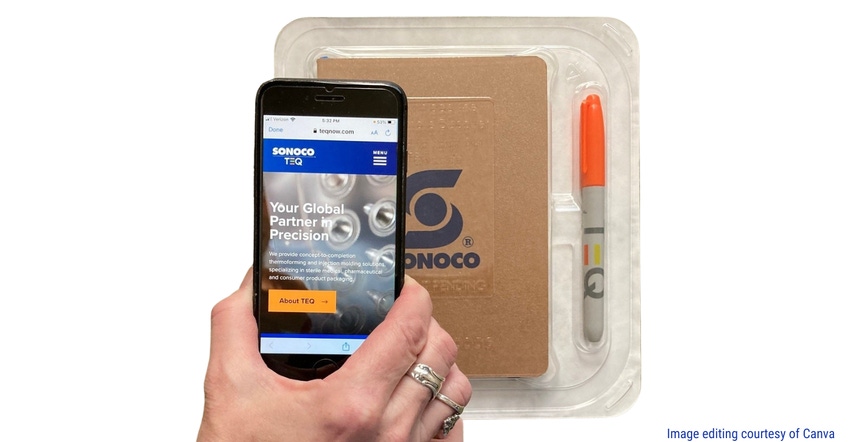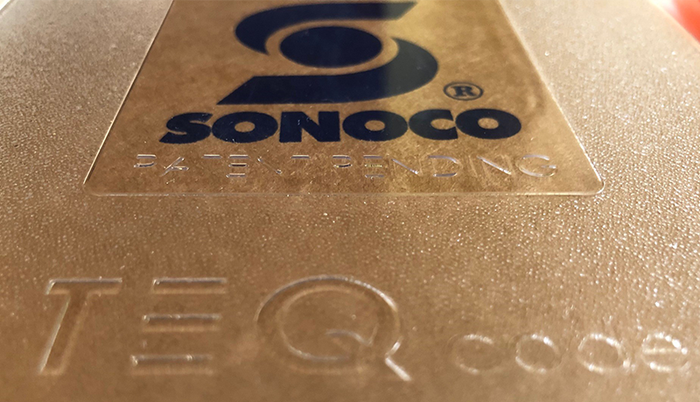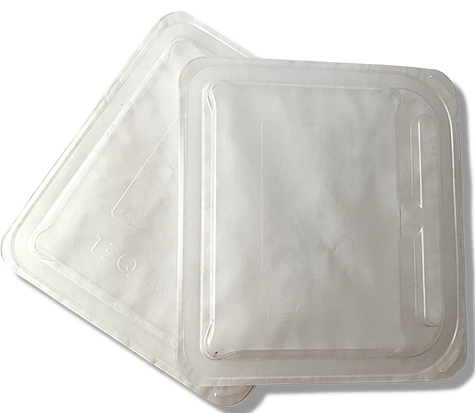Thermoform Packaging Powered by Digital Watermarks
Covert markings for medical packaging enable vital benefits from factory floor through end-of-life recycling including consumer engagement, sustainability, and traceability.
July 27, 2022

Subtle things can be the most influential.
A case in point is the visionary Holy Grail 2.0 recycling initiative that relies on Digimarc’s digital watermarking technology, which is essential to automating the packaging sortation process.
It makes possible the high-speed reading of a container's polymer type by vision systems that read the watermarks.
Paired with robotics, the combination permits packaging sortation at commercial scale.
Sonoco TEQ is expanding the potential of Digimarc’s digital watermarking into thermoform packaging in a way that can benefit stakeholders along the entire value chain from manufacturing to brand owner to consumer and beyond.
Todd McDonald, TEQ’s global director of sales and marketing, says the concept started with a bottle of wine.
“Seeing a digital watermark on the bottle and all that it did with information and consumer engagement through a smartphone app sparked the idea of using the technology for thermoform medical packaging,” he tells us.
A problem with a ready-made solution.
To make that happen, TEQ’s Plan A was to embed a code in the plastic sheet during manufacturing.
It's a great idea, but making that work was a major challenge.
“We first tried to engrave a readable 3D-bar code, which was an epic fail,” McDonald admits. “Then we connected with Digimarc.”
That was February 2021 and was when things kicked into higher gear.
Tomas Filler, senior manager, R&D at Digimarc, explains how the tech works.
“The TEQ Code is based on Digimarc Watermark technology, which has been used in the print environment for more than 20 years. The Digimarc Watermark is a slight texture that can be printed, engraved into a mold, or made directly onto the plastic that carries digital identifiers, such as the UPC-A code, or Digimarc ID. Digital watermarks are designed to be imperceptible for regular consumers or can be built-in existing textures used in customer artwork today. Machines equipped with camera and processing algorithms such as phones, barcode scanners, or other machine-vision cameras can then detect the presence of such watermark and connect the physical object with its digital twin in Digimarc Product Cloud.”
Meanwhile, TEQ found a technique that worked — laser engraving of the thermoform mold.
As seen in the close-up image of the sample packaging below, the textured surface that “frames” the surface of the thermoform is the digital watermark pattern. Each individual watermark is about the size of a postage stamp, but it’s repeated across the surface to optimize readability by a smartphone or machine vision system.
On a smartphone, the Digimarc app leads the user to a customer-specified website.

“It could be a website that we host for customers or for customers to host,” McDonald says. “It’s basically the consumer’s signal that ‘I'm here, tell me your packaging story.’ We’re giving customers the opportunity to let their package speak for their brand and for the application.”
The information the customer sees on their smartphone is dynamic — the customer can change it at any time.
Digital watermarks' sweet spot: medical packaging.
The technology brings market-specific advantages for TEQ’s focus on medical packaging that start with sustainability improvements.
For one thing, McDonald suggests the tech may permit the reduction or possible elimination of volumes of printed materials.
“Packaging in a regulated space like medical needs to communicate more information than in other categories,” he explains. “For example, the code could replace Information for Use (IFU) inserts and booklets. Medical devices may require huge booklets that few people read, though it’s mandatory for regulatory compliance.”
It’s even more complicated than that, according to Tim Collins, TEQ account manager.
“There’s also the question of how many different languages must be included in the IFUs besides English: What about Spanish, French…how far do you go?”

There’s another benefit in the medical market.
“Some might be interested in this technology because of ISO 11607 and the need to prove sterility,” suggests McDonald. “It’s going to be important to help nurses do that.”
The standard states the package must be able to maintain sterility of the device throughout its lifetime. Also, the FDA requires directions for use that are adequate to assure safe use and safe preparation of the device for use.
“I believe the TEQ code could accomplish this,” says McDonald, “but every medical device manufacturer will need to determine if this is suitable for their intended use.”
An idea he proposes is that a customer could link to a video that communicates to medical personnel how to open and use the package.
Just about anything is possible.
Benefits for track-and-trace, recalls, and more.
For medical and other markets there’s another challenge brands face — the dilemma when an ingredient or other aspect of a product or medical device is added or changed.
“Does that mean that the entire associated inventory has to be reworked or purged because of this?” Collins asks.
The FDA is clear and strict about adherence.
With the Digimarc tech, those instructions can be quickly updated online without loss or recall.
“It’s about cost and convenience,” Collins remarks.
However, McDonald points out that the watermark’s benefits can start immediately after thermoforming. For instance, the code could inform downstream machinery of the specific parameters for a subsequent operation.
One example is the temperature of the sealing film for a particular stock-keeping unit.
There’s also the option for track-and-trace with a caveat — it would only be traceable to the stock-keeping unit (SKU) level, McDonald acknowledges.
Still, the tech is a seamless way for brands to increase the capability for authentication and narrow the scope of products needing to be recalled or discarded.
Options for customers start at the very beginning and extend to the type of plastic chosen for the thermoform. TEQ’s product portfolio numbers more than 25 different materials including polypropylene and polyethylene as well as the latest biodegradable and recycled plastics.
However, most medical product customers choose PETG, McDonald says.
“Our injection molding facility has experience with commodity plastics, engineering plastics, and elastomers,” he adds.
Finally, at the thermoform’s end-of-life, a Holy Grail 2.0 watermark could enable the integration into automated sortation and recycling of the packaging for either standard mechanical recycling or an advanced recycling method such as depolymerization.
You May Also Like


